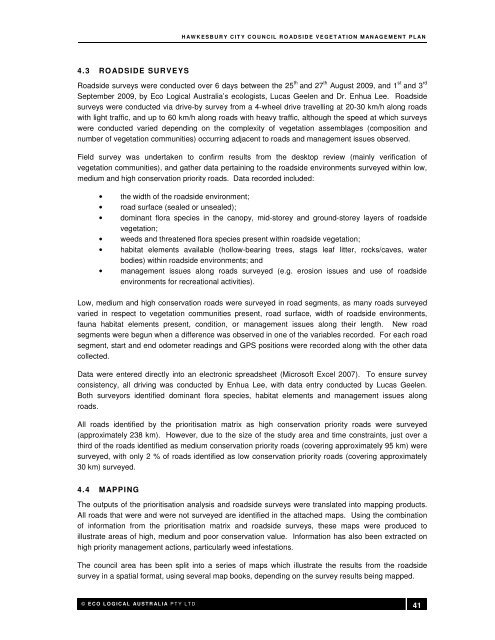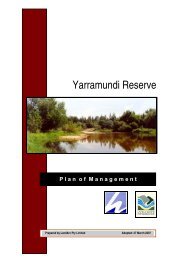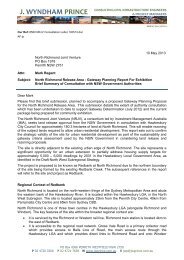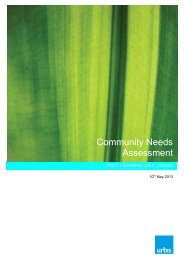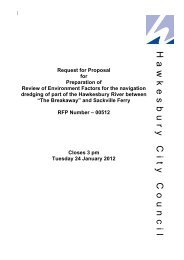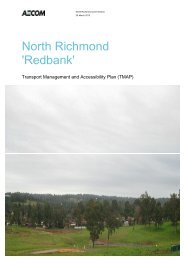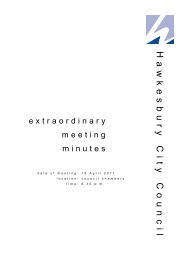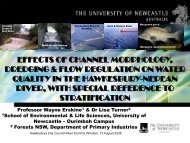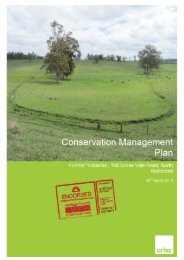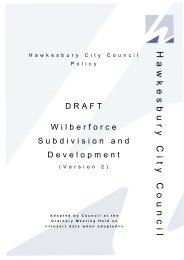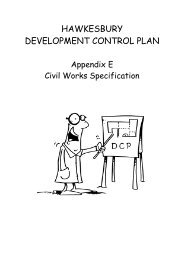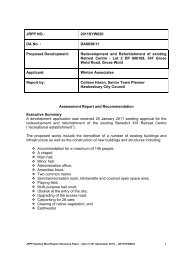Attachment 1 to Item 53 - Roadside Vegetation Management Plan
Attachment 1 to Item 53 - Roadside Vegetation Management Plan
Attachment 1 to Item 53 - Roadside Vegetation Management Plan
Create successful ePaper yourself
Turn your PDF publications into a flip-book with our unique Google optimized e-Paper software.
H AW K E S B U R Y C IT Y C O U N C IL R O AD S ID E V E G E T AT IO N M AN AG E M E N T P L AN<br />
4.3 ROADSIDE SURVEYS<br />
<strong>Roadside</strong> surveys were conducted over 6 days between the 25 th and 27 th August 2009, and 1 st and 3 rd<br />
September 2009, by Eco Logical Australia’s ecologists, Lucas Geelen and Dr. Enhua Lee. <strong>Roadside</strong><br />
surveys were conducted via drive-by survey from a 4-wheel drive travelling at 20-30 km/h along roads<br />
with light traffic, and up <strong>to</strong> 60 km/h along roads with heavy traffic, although the speed at which surveys<br />
were conducted varied depending on the complexity of vegetation assemblages (composition and<br />
number of vegetation communities) occurring adjacent <strong>to</strong> roads and management issues observed.<br />
Field survey was undertaken <strong>to</strong> confirm results from the desk<strong>to</strong>p review (mainly verification of<br />
vegetation communities), and gather data pertaining <strong>to</strong> the roadside environments surveyed within low,<br />
medium and high conservation priority roads. Data recorded included:<br />
• the width of the roadside environment;<br />
• road surface (sealed or unsealed);<br />
• dominant flora species in the canopy, mid-s<strong>to</strong>rey and ground-s<strong>to</strong>rey layers of roadside<br />
vegetation;<br />
• weeds and threatened flora species present within roadside vegetation;<br />
• habitat elements available (hollow-bearing trees, stags leaf litter, rocks/caves, water<br />
bodies) within roadside environments; and<br />
• management issues along roads surveyed (e.g. erosion issues and use of roadside<br />
environments for recreational activities).<br />
Low, medium and high conservation roads were surveyed in road segments, as many roads surveyed<br />
varied in respect <strong>to</strong> vegetation communities present, road surface, width of roadside environments,<br />
fauna habitat elements present, condition, or management issues along their length. New road<br />
segments were begun when a difference was observed in one of the variables recorded. For each road<br />
segment, start and end odometer readings and GPS positions were recorded along with the other data<br />
collected.<br />
Data were entered directly in<strong>to</strong> an electronic spreadsheet (Microsoft Excel 2007). To ensure survey<br />
consistency, all driving was conducted by Enhua Lee, with data entry conducted by Lucas Geelen.<br />
Both surveyors identified dominant flora species, habitat elements and management issues along<br />
roads.<br />
All roads identified by the prioritisation matrix as high conservation priority roads were surveyed<br />
(approximately 238 km). However, due <strong>to</strong> the size of the study area and time constraints, just over a<br />
third of the roads identified as medium conservation priority roads (covering approximately 95 km) were<br />
surveyed, with only 2 % of roads identified as low conservation priority roads (covering approximately<br />
30 km) surveyed.<br />
4.4 MAPPING<br />
The outputs of the prioritisation analysis and roadside surveys were translated in<strong>to</strong> mapping products.<br />
All roads that were and were not surveyed are identified in the attached maps. Using the combination<br />
of information from the prioritisation matrix and roadside surveys, these maps were produced <strong>to</strong><br />
illustrate areas of high, medium and poor conservation value. Information has also been extracted on<br />
high priority management actions, particularly weed infestations.<br />
The council area has been split in<strong>to</strong> a series of maps which illustrate the results from the roadside<br />
survey in a spatial format, using several map books, depending on the survey results being mapped.<br />
© E C O L O G IC A L AU S T R AL I A P T Y L T D<br />
41


